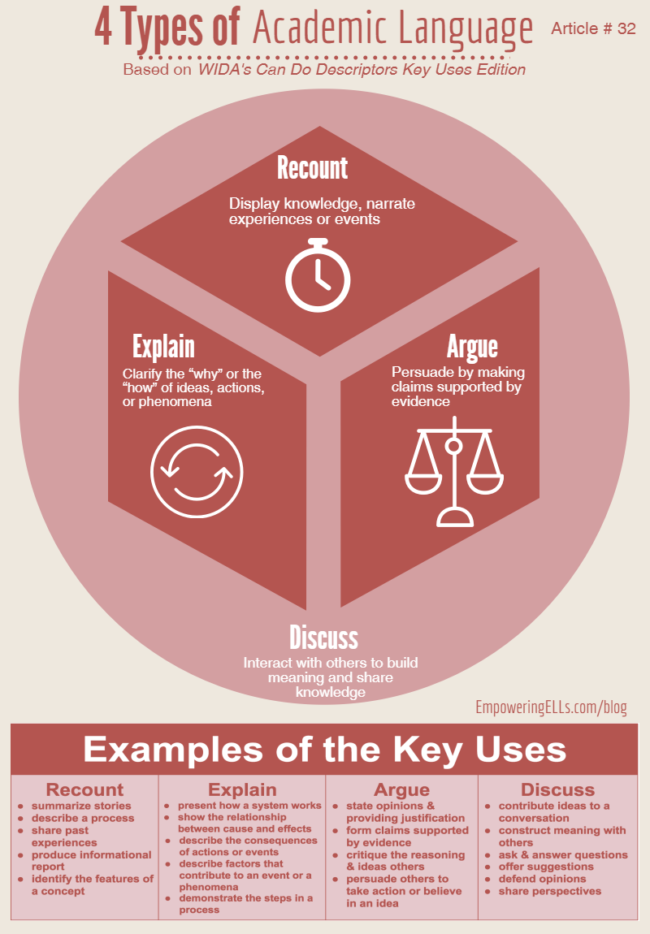Part 13 of WIDA’s Essential Actions Series. Click here to read the first article in the series.
I once chaperoned a group of Model United Nations (MUN) students as they participated in a MUN Conference. Each student represented the interests of a particular country and entered debates with the goal of persuading other Delegates to vote favorably for their country. The language used to debate was particularly scripted, and no deviation was allowed. It looked like this:
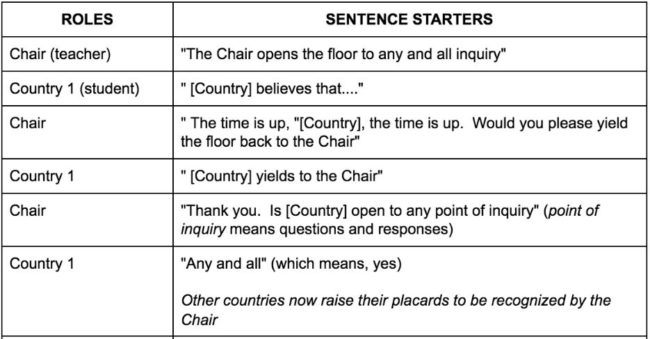
The Model MUN coach said that she spent days teaching the students to use this language. Without it, the students wouldn’t be able to participate.
Teaching Academic Language
This example demonstrates the need to teach the language required to achieve academic success. That’s the central message of WIDA’s Action 10 from their Essential Actions: A Handbook for Implementing WIDA’s Framework for English Language Development Standards.
WIDA’S Action 10 encourages educators to explicitly teach the language needed to be successful on a given task (Gottlieb, 2013). The previous article presented a case study that showed how to teach ELs to use science-specific language. In this article, I broaden the scope to share how most content areas use language in at least four specific ways.
WIDA analyzed the language used most frequently in college papers, peer-reviewed journals, and reports produced by the business world. They also examined the Common Core State Standards and the Next Generation Science Standards for the types of language that these framework standards expected of students.
WIDA found that the type of language used most often in academic and business settings were recount, explain, argue, and discuss. They decided to group these four forms of languages into what they call Key Uses because they represented the “keys” to academic success (Board of Regents of the University of Wisconsin System, 2016; Lundgren, 2015).
Language Across the Disciplines
These 4 Key Uses provide a common framework for students to understand academic language. For example, when educators across disciplines have a shared understanding of the word “explain”, ELs can then learn this common understanding and implement it. If a student is taught in history class how to explain why the printing press changed society, she’ll know exactly how to structure her writing since she was already expected to explain in science why coral reefs are important to coastal communities.
The task of explaining remains the same, but the content and context can change. However, the more she does these tasks in any context, the more they reinforce each other; the task in science class is reinforced by the task in history class. The student will be more successful in any area because her teachers have explicitly taught how to explain her ideas in writing. When this student enters college and joins the workforce, she’ll be prepared to produce reports that explain why things occur or how things work.
Now that we’ve learned why these Key Uses are important, let’s examine each of them in more detail.
RECOUNT
A recount structure is used to narrate events or identify facts. If a teacher want students to narrate a story or experience, then he will have to reinforce the importance of correctly sequencing events. An example from history class might be to recount the events that occurred after Hernan Cortez made contact with the Aztecs.
Sequence recounts have signal words such as “first”, “then”, “after”; “finally” that signify changes in events. One easy framework when teaching narrative recount is having students identify the “W” Questions – what, when, where, and how. In our history example, we might have students recount what Cortez was trying to find, where was he trying to go, and how the Aztecs received him.
Another purpose of recounting is to display knowledge. When used for this purpose, the focus is on identifying facts, not sequencing events. For example, a science teacher might ask students to recount all the types of renewable forms of energy. In this example, there are no events at all, just facts that need to be identified. When students are expected to recount the features something, teachers can use a mind map like the one below. The main topic is at the center and is surrounded by its identifying traits.
For example, if students are asked to describe a cat, the cat would be the center of the mind map. The traits of a cat are its appearance, behavior, diet and so forth. Each trait has a set of details. We can break down the cat’s appearance into finer details to describe its fur, tail, legs, whiskers, and so forth.
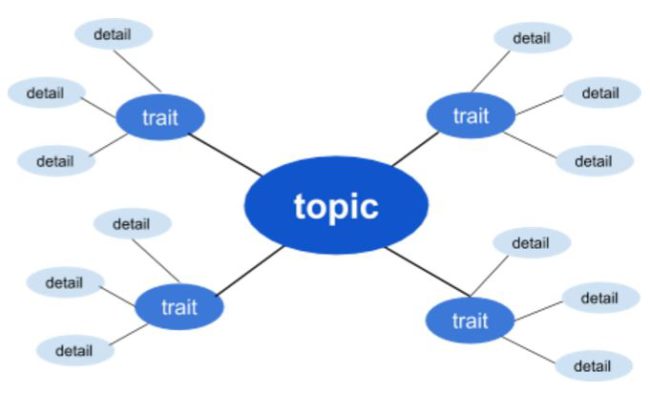
EXPLAIN
An explain structure clarifies why or how a phenomenon occurs. It emphasizes the connections between events or the cause-effect relationship. For example, if an Economics teacher wants students to explain the factors leading up to the American Recession in 2008, she can teach them to use an explain diagram like the one below that consist of boxes detailing the the causes and separate ones for the ultimate effects.
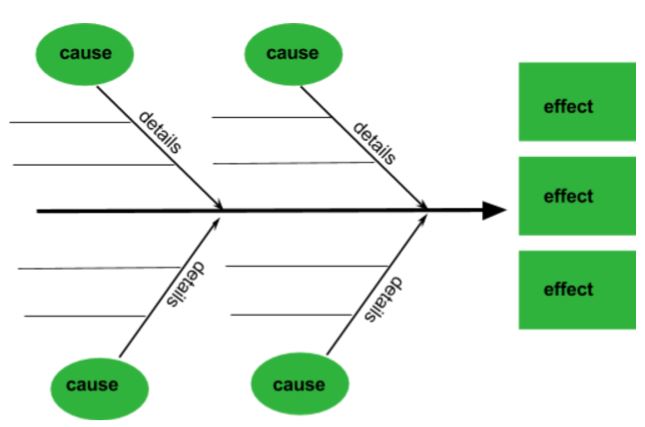
If you want to have students explain factors of something, you can replace “cause” for “factors” and leave the “effect” boxes. Every factor has a particular effect on the phenomena. For example, the drama teacher might want students to explain how a play is produced. The diagram should have boxes that capture the factors involved in running the play such as lighting, staging, music, and custom design.
ARGUE
In an academic context, to argue means to create a claim and provide justifications to support it. After stating the claim, students should provide a reason that leads them to this assertion followed by evidence that supports their reason. An example might come science class where the teacher asks students to argue whether climate change is a real or fictional phenomenon.
Students are sent off to read articles, watch documentaries, and listen to podcasts to gather information. Their research forms their claim, which is supported by the evidence that they find.
The most sophisticated arguments present a counterargument to a claim. By providing one, a students show they are analytical and aware of opposing perspectives. These students can also provide a rebuttal to the counterargument to further reinforce their claim. Use the following diagram to guide your students as they structure a thoughtful argument.
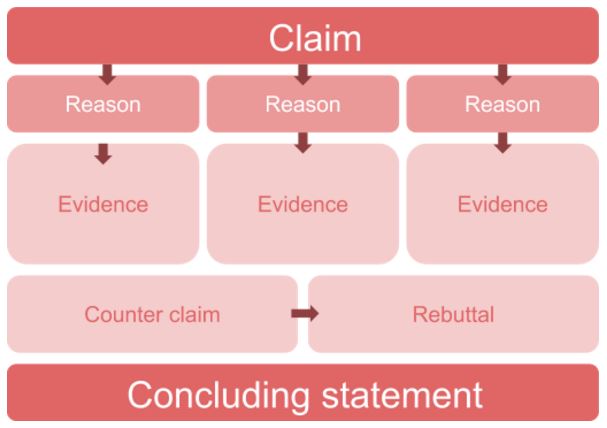
DISCUSS
Many educators explicitly teach writing to ELs, but how often do we explicitly teach how to participate in a discussion? For some ELs, their cultural expectations might not permit people to ask questions, provide opinions, offer inferences, or assert claims. In U.S. schools, these forms of interactions are highly valued and welcomed, but many ELs don’t know how to contribute, so they remain silent.
But remaining silent handicaps them from fully participating in college or the workplace where 21st Century tasks are becoming increasingly more collaborative. We have to first teach ELs that contributing in discussions is both valued and expected.
One way to do so is to point out the types of contributions students can make during discussions, such as asking questions, offering an analysis, forming opinions, and making connections. Coax students to gradually experience each contribution one by one. For example, instruct students to provide an opinion about a video they just watched by producing a Quick Write that starts with “I disagree/agree with…because….”
Then let students share their opinions and discuss their reasoning. Allow ELs to observe their peers assert claims and defend opinions. Even if they’re hesitant to jump head first into the discussion, at least they formed their own opinions and witnessed that opinions are valued and welcomed in discussions. Allowing them to tiptoe into a discussion honors their understandable hesitancy.
Takeaways
English language teachers (ELT) love the phrase Every teacher is a teacher of language because it rallies all teachers around ELs, not just ELTs. If content specialists commit to teaching the Key Uses, they’ll gift ELs with valuable tools that they’ll use in school and in life.
Next Post
We’ll visit WIDA’s Action 11, which is about planning language instruction around the topics found in content classes – a practice pioneered by Echevarria, Vogt, and Short (2008). I’ll provide several case studies for how to literacy instruction around disciplines other than English literature. If you have the room in your curriculum, I hope this action encourages you to use science and social studies topics as the context for teaching English.
Board of Regents of the University of Wisconsin System (2016). WIDA can do descriptors: Key uses edition 9-12.
Echevarria, J., Vogt, M. E., & Short, D. J. (2008). Making content comprehensible for English learners: The SIOP® model (3rd ed.). Boston: Allyn and Bacon.
Gottlieb, M. (2013). Essential Actions: A Handbook for Implementing WIDA’s Framework for English Language Development Standards. Madison: Board of Regents of the U of Wisconsin System.
Lundgren, C. (2015). WIDA: Introducing the Key Uses of Academic Language. Retrieved from http://www.slideshare.net/MELEdConference/wida-introducing-the-key-uses-of-academic-language

